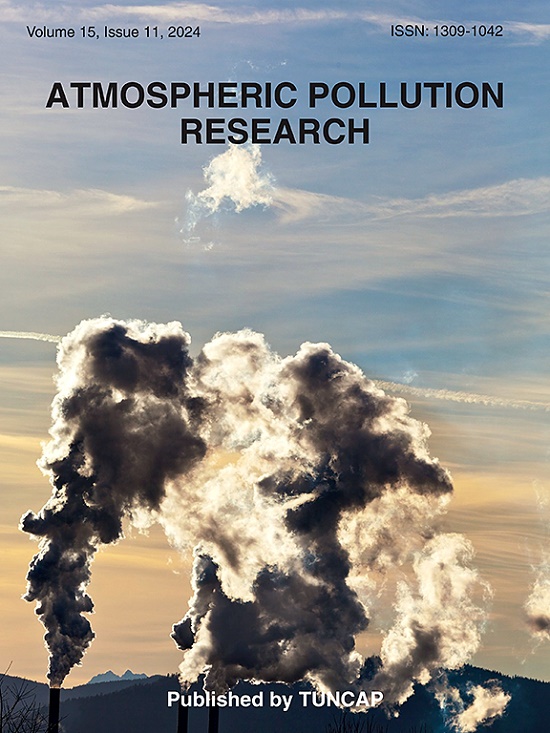利用开放遥感数据和机器学习进行日常地面臭氧预测模型:大陆生物地理区域的时空洞察
IF 3.9
3区 环境科学与生态学
Q2 ENVIRONMENTAL SCIENCES
引用次数: 0
摘要
地面臭氧(O3)污染对环境和公共卫生构成重大挑战,需要准确的预测模型进行有效监测和管理。在本研究中,我们观察到91%的观测到的地面臭氧方差可以使用来自Sentinel-5P TROPOMI的滞后数据和来自ERA5-Land数据集的数据,在意大利威尼托地区大陆部分由机器学习(ML)部署的训练有素的人工智能(AI)模型上进行解释。使用当地空气质量监测站的数据作为地面真值数据。研究时间为2019年1月至2022年12月。时空ML模型预测RF、XGB和LSTM的日O3浓度RMSE分别为9.05、8.87和10.87 μg/m3。不含时空信息的模型精度较低,RMSE分别为10.88 μg/m3、11.45 μg/m3和12.06 μg/m3,表明时空信息可使模型性能提高10%以上。而时空独立模式更具有跨大陆区域和不同季节的可移植性。结果提供了空间分辨率为~ 11.13 km(0.1°)的地面臭氧空间连续图,有助于估计没有地面站的地区的污染水平。空间分析结果显示,模型在所有站点的精度均较高,而时间分析结果显示夏季月份的精度较低。总体而言,虽然本研究中开发的模型的空间分辨率不足以用于城市地区的风险管理,但它们对大陆地区没有地面站的地区的日常地面O3监测具有实际意义。本文章由计算机程序翻译,如有差异,请以英文原文为准。

Harnessing open remote sensing data and machine learning for daily ground-level ozone prediction models: Spatio-temporal insights in the continental biogeographical region
Ground-level ozone (O3) pollution poses significant environmental and public health challenges and requires accurate predictive models for effective monitoring and management. In this study we observe that 91 % of the observed ground-level O3 variance can potentially be explained using time-lagged data from Sentinel-5P TROPOMI and data from ERA5-Land datasets on a trained artificial intelligence (AI) model deployed by machine learning (ML) in the continental part of the Veneto region in Italy. Data from local air quality monitoring stations were used as ground truth data. The study period is from January 2019 to December 2022. Spatio-temporal ML models predicted daily O3 concentrations with RMSE of 9.05 μg/m3, 8.87 μg/m3 and 10.87 μg/m3 respectively for RF, XGB and LSTM. Models without spatio-temporal information gave lower accuracy, with RMSE of 10.88 μg/m3, 11.45 μg/m3 and 12.06 μg/m3 respectively, showing that spatio-temporal information can improve performance more than 10 %. However, spatio-temporal independent models are more transferable across continental region and different seasons. Results provide spatially continuous maps of ground-level O3 with a spatial resolution of ∼11.13 km (0.1°), helping to estimate pollution levels in areas without ground stations. Spatial analysis of the models’ performance showed consistent high accuracy across all stations, while temporal analysis revealed lower performance in summer months. Overall, while the spatial resolution of the models developed in this study is insufficient for risk management in urban areas, they have practical implications for daily ground-level O3 monitoring in areas without ground stations in the continental region.
求助全文
通过发布文献求助,成功后即可免费获取论文全文。
去求助
来源期刊

Atmospheric Pollution Research
ENVIRONMENTAL SCIENCES-
CiteScore
8.30
自引率
6.70%
发文量
256
审稿时长
36 days
期刊介绍:
Atmospheric Pollution Research (APR) is an international journal designed for the publication of articles on air pollution. Papers should present novel experimental results, theory and modeling of air pollution on local, regional, or global scales. Areas covered are research on inorganic, organic, and persistent organic air pollutants, air quality monitoring, air quality management, atmospheric dispersion and transport, air-surface (soil, water, and vegetation) exchange of pollutants, dry and wet deposition, indoor air quality, exposure assessment, health effects, satellite measurements, natural emissions, atmospheric chemistry, greenhouse gases, and effects on climate change.
 求助内容:
求助内容: 应助结果提醒方式:
应助结果提醒方式:


